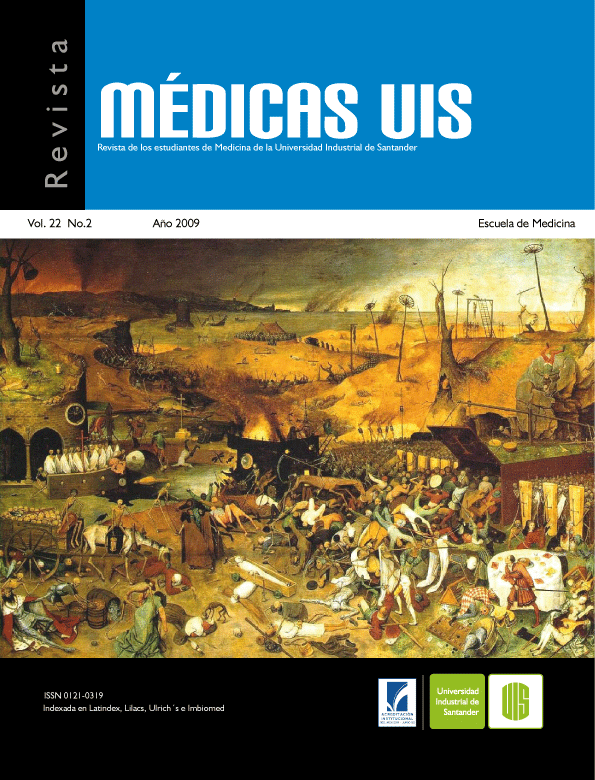Abstract
INTRODUCTION: Adverse drug reactions represent an important public health problem. However, the importance of this problem in ambulatory care in Colombia is unknown.
OBJECTIVE: establishing the prevalence of adverse drug reactions as the reason for visiting an emergency department.
MATERIALS AND METHODS: the study took place at the "Luis Carlos Galán Sarmiento Empresa Social del Estado" Emergency Department's Central Outpatient Centre in Bogotá. It was carried out between September 20th and October 2nd 2004. The adverse drug reactions were identifed by an evaluator who reviewed all clinical histories, noting when physicians had indicated that a reaction had occurred. The patients were contacted. Two people evaluated causality, the degree of preventability and the mechanism producing the adverse drug reactions.
RESULTS: 45 adverse drug reactions were recorded in 1,395 visits made during a two-week period (2.8%). Modifed spontaneous report detected 26.7% of adverses drug reactions identifed by active search. 73.3% of all identifed adverses drug reactions occurred in females, 64.9% in people older than 60; 75,6% were possible (causality assessment), 95,6% were non serious, 44,4% were of A type (mechanism producing the adverses drug reactions), and 22,2% were preventable.
CONCLUSIONS: adverses drug reactions represent an important proportion of the reasons for outpatient consultation; the modifed spontaneous report system detected a fourth part of those. There were no statistically signifcant differences between gender and adverse effects frequency. Adverse drug reactions occurred more frequently in elderly patients. Two out of each 10 adverses drug reactions could have been prevented.
Key words: Pharmacoepidemiology. Drug utilization. Medicamentous disease. Emergency medical services. Ambulatory care. Secondary effect.
References
2. Lazarou J, Pomeranz BH, Corey PN. Incidence of adverse drug reactions in hospitalized patients: a meta-analysis of prospective studies. JAMA 1998;279:1200-5.
3. WHO Collaborating Centre for International Drug Monitoring. Viewpoint, Part 1. Uppsala: WHO Collaborating Centre for International Drug Monitoring, 2002.
4. Bustamante C, Calderón C, Castillo I, Cifuentes P, Ramírez J. Reacciones adversas a medicamentos como motivo de ingreso al servicio de urgencias de la Clínica Universitaria Teletón. Cuadernos de Medicina en Investigación y Salud 2007;1:33-41.
5. Güemes M, Sanz E, García M. Reacciones adversas y problemas relacionados con medicamentos en un servicio de urgencia. Rev Esp Salud Pública 1999;73:511-8.
6. Muñoz M, Ayani I, Rodríguez-Sasiain M, Gutiérrez G, Aguirre C. Monitorización en un servicio de urgencias de reacciones adversas causadas por medicamentos en niños y adultos. Med Clin (Barc) 1998;11:92–8.
7. Raschetti R, Morgutti M, Menniti-Ippolito F, Belisari A, Rossignoli A, Longhini P, et al. Suspected adverse drug events requiring emergency department visits or hospital admissions. Eur J Clin Pharmacol 1999;54:959-63
8. Budnitz D, Shehab N, Kegler S, Richards Ch. Medication Use Leading to Emergency Department Visits for Adverse Drug Events in Older Adults. Ann Intern Med 2007;147:755-65.
9. Bednall R, McRobbie D, Hicks A. Identification of medication-related attendances at an A and E department. J Clin Pharm Ther 2002;28:41-5.
10.Nieremberg D, Melmon K. Introduction to clinical pharmacology and rational therapeutics. En: Clinical Pharmacology. New York: McGraw – Hill, 2002.
11. Gandhi T, Weingart S, Borus J, Seger A, Peterson J, Burdick E, et al. Adverse drug events in ambulatory care. N Engl J Med 2003;348:1556-64.
12. Gurwitz J, Field T, Harrold L, Rothschild J, Debellis K, Seger A, et al. Incidence and preventability of adverse drug events among older persons in the ambulatory setting. JAMA 2003;289:1107-16.
13. Thomsen LA, Winterstein AG, Søndergaard B, Haugbølle LS, Melander A. Systematic review of the incidence and characteristics of preventable adverse drug events in ambulatory care. Ann Pharmacother 2007;41:1411-26.
14. Martin R, Kapoor K, Wilton L, Mann R. Underreporting of suspected adverse drug reactions to newly marketed (“black triangle”) drugs in general practice: observational study. BMJ 1998;317:119–20.
15. Aronson J, Ferner R. Clarification of Terminology in Drug Safety. Drug Saf 2005;28:851–70.
16. Meyboom R. Causality assessment revisited. Pharmacoepidemiol Drug Saf 1998;7:S-63–5.
17. Lagnaoui R, Moore N, Fach J, Longy-Boursier M, Bégaud B. Adverse drug reactions in a department of systemic diseases-oriented internal medicine: prevalence, incidence, direct costs and avoidavility. Eur J Clin Pharmacol 2000;55:181–6.
18. Sweetman S (Ed). Martindale: The complete drug reference. London: Pharmaceutical Press, 2004.
19. Rawlins MD, Thompson JW. Pathogenesis of adverse drug reactions. In: Davies DM, ed. Textbook of adverse drug reactions. Oxford: Oxford University Press, 1977: 10.
20. Hunziker T, Bruppacher R, Kuenzi U, Maibach R, Braunschweig S, Halter F, et al. Classification of ADRs: a proposal for harmonization and differentiation based on the experience of the Comprehensive Hospital Drug Monitoring Bern/St. Gallen, 1974-1993. Pharmacoepidemiol Drug Saf 2002;11:159-63.
21. Alvarez-Requejo A, Carvajal A, Bégaud B, Moride Y, Vega T, Arias LH. Under-reporting of adverse drug reactions. Estimate based on a spontaneous reporting scheme and a sentinel system. Eur J Clin Pharmacol 1998;54:483-8.
22. Moride Y, Haramburu F, Requejo AA, Bégaud B. Under-reporting of adverse drug reactions in general practice. Br J Clin Pharmacol 1997;43: 177–81.
23. Segura O, Maldonado C. Las reacciones adversas a medicamentos: una aproximación desde el punto de vista económico. Biomédica 2003; 23: 401-7.
24. Budnitz D, Pollock D, Weidenbach K, Mendelsohn A, Schroeder T, Annest J. National Surveillance of Emergency Department Visits for Outpatient Adverse Drug Events. JAMA. 2006;296:1858-66.
